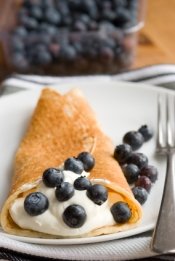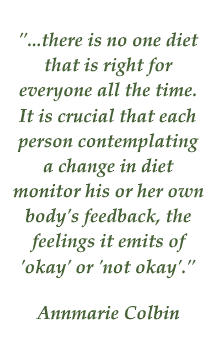Crème Fraîche Recipe
Keep homemade crème fraîche at your fingertips
If you're looking for a creme fraiche recipe, you'll find 3 here. Creme fraiche is highly versatile and will become an indispensable ingredient in your kitchen. Save the expense of buying it and instead enjoy wholesome homemade creme fraiche.
Although creme fraiche (pronounced "crem fresh") is actually French, it is often described as "European-style sour cream". Many of us in America are discovering creme fraiche to be so much more appealing than our store-bought sour cream, with its harsher flavor and artificial undertones. However creme fraiche isn't available in all parts of the country. Luckily we can make our own facsimile of it at home.
What's the difference between
crème fraîche and sour cream?
Both sour cream and creme fraiche are cultured milk products, meaning they are created by the action of live bacteria, just like yogurt. Traditionally, both were made from naturally aged cream, with the naturally-occuring bacteria in the raw milk providing the culturing. Sour cream was cream left to ripen until it soured, and creme fraiche was only slightly ripened, so it had a milder flavor. There are all kinds of names, from all over the world, used to describe various states of ripened raw milk or cream; clabber in the southern U.S. and crema in Mexico to name but two.
In France, most creme fraiche is produced by time-honored tradition including the use of raw milk. But in the U.S., any milk products crossing state lines must be pasteurized, killing the naturally-occurring bacteria and making it necessary to add the desired bacteria strains back in. So even store-bought creme fraiche in America will differ from the real thing in France. Not only is the milk different, but the bacteria native to France are unique.
Besides the degree of ripening, or sourness, creme fraiche and sour cream have another major difference between them. Creme fraiche is made from heavy cream, and sour cream from lighter creams.
According to FDA guidelines, sour creams must begin with cream of at least 18% milkfat, or butterfat. There are no FDA guidelines for creme fraiche, but according to wikipedia, creme fraiche uses cream of around 28% butterfat. A a quick online check shows Vermont Creamery creme fraiche has 42% butterfat and Kendall Farms has 40%. This higher butterfat content makes creme fraiche more stable in cooking applications and richer in flavor.
If you really enjoy the extra tartness of sour cream, see here for how to make homemade sour cream.
Crème fraîche vs. crème fraîche?

There seems to be some confusion around the use of the term "creme fraiche". It can mean different things to different people and to different chefs. Some use the term for a whipped cream or whipped creme fraiche, with sweetener added, similar to what we might call "whipped cream" or "whipped topping" or even "Cool-Whip" in America. Others are referring simply to the cultured cream product.
And there are two conflicting viewpoints on the desired thickness of creme fraiche, some wanting it thick like custard and others wanting it to remain pourable. It seems the thick custard-like consistency is a modern taste, and the liquid consistency a traditional one.
The truest form of creme fraiche can really only be had in France, where the particular strains of bacteria are native. Creme fraiche produced far from France can only attempt to mimic the qualities and flavors of the real thing. This is similar to taking a sour dough starter out of San Francisco or London -- it won't produce the same tasty loaf of bread.
The versatility of crème fraîche
In cooking, creme fraiche is more versatile than sour cream. Its milder flavor makes it appropriate in both sweet and savory applications, whereas the sourness of sour cream relegates it mostly to savory dishes. With just a bit of sweetener and fresh fruit or berries, creme fraiche becomes a dessert almost all by itself.
Due to its higher fat content, creme fraiche doesn't "break" or curdle when cooked, the way sour cream does, making it ideal in creamy cooked sauces, soups, and stews. Unlike sour cream, it can be whipped. And as a condiment, only your imagination will limit its uses. I've often found it to be a perfect "something" when something's missing in a dish I've already served.
Should we worry about creme fraiche's butterfat content? No. Butterfat is one of those natural fats that support a healthy body, and is a medium-chain fatty acid that doesn't contribute to weight gain the same as other fats. I, along with many others, can personally attest to this. Instead, the rich flavor not only makes our food taste better, but it makes it more satisfying, leaving us feeling full longer.
What type of cream to use
As easy as the recipes for homemade creme fraiche are, there's one thing that could prove difficult, depending on where you live: finding cream that hasn't been ultra-pasteurized or ultra high temperature (UHT) pasteurized. It took me a long time to find a source, but I finally found a dairy bottling plant that sells straight pasteurized cream, but only if you drive to their plant to pick it up. I now drive an hour and half every month to get it.
Raw cream can be used if you have a source for it. It will likely be pricey. In my area, I can get it for $11 per quart, whereas the pasteurized cream is $4.50 per 1/2 gallon (making it $2.25 per quart). On a limited budget, the pasteurized cream is a decent compromise since pasteurization is most destructive of the liquid part of milk, which there's less of in cream, and not the fat molecules. Milk fat/butterfat/butter, is stable at regular pasteurization temperatures. It's the process of homogenization that is thought to destroy the milk fat particles (and separated cream doesn't undergo homogenization). (See here for a brief overview of milk processing.)
If you use raw cream and are wanting a thick-style creme fraiche,
you may want to add some thickener. The trouble with culturing raw milk
and cream is that the many naturally-occurring (and beneficial) bacteria
still living in the raw milk can overly compete with your starter
bacteria. Often, the resultant cultured product doesn't thicken as much
as we'd like -- but it's chock full of good "beasties" for you.
This is one reason so many cultured dairy recipes have you pasteurize raw milk yourself before adding the culture inoculant. This kills off any competitors. But those of us who pay dearly for quality raw milk are usually reluctant to kill off the "beasties" it came with. A better solution, in my opinion, is to add some pectin or gelatin for thickening power, but I'm not sure how that would effect its cooking characteristics. It might separate when cooked. Or, try using it as is, see how thin it actually is and decide if maybe you can live with that.
The crème fraîche recipe list
Anytime you're dealing with cultures and fermentation, results can vary from batch to batch depending on your cream and the temperature and length of time it ferments. My homemade creme fraiche isn't made from "heavy" cream as specified by the recipes so it's always pretty thin after the allotted time, but it thickens after a couple of days in the fridge. The reason I don't just leave it out longer is that it can become too tart for my taste.
Creme Fraiche Recipe I is the most prevalent recipe for homemade creme fraiche.
Creme Fraiche Recipe I
1 cup heavy cream, not ultra-pasteurized
1 tablespoon buttermilk, store-bought creme fraiche, or creme fraiche from previous batch
Mix both ingredients in a clean, lidded container. Let sit at room temperature for 12-24 hours, then refrigerate.
Creme Fraiche Recipe II so happens to be what I've been making for several months now and been calling "cream yogurt". I use it extensively in Homemade Frozen Yogurts as they're a great alternative to sugary ice cream. I put this recipe here because others are making the same thing and calling it creme fraiche. To me, it's still cream yogurt.
Creme Fraiche Recipe II
1 cup heavy cream, not ultra-pasteurized
1 1/2 tablespoons whole milk yogurt, unflavored
Warm cream gently over low heat until a thermometer reads anywhere from 100-110 degrees. Put yogurt in lidded container and whisk til smooth. Add a tablespoon of warmed cream and whisk in. Slowly pour in remaining warmed cream, stirring thoroughly all the while. Put lid on container and place in a warm spot, 95-100 degrees, for 8-12 hours.
Creme Fraiche Recipe III comes from an old book of mine I've been carrying around for years: Better Than Store-Bought, by Witty and Colchie, published in 1979. The authors claim this recipe creates a creme fraiche most closely resembling the real thing. It remains pourable thanks to the stir before going into the fridge, which they feel gives it more versatility than custard-thick creme fraiche.
Creme Fraiche Recipe III
1 cup heavy cream (not ultra pasteurized)
2 tablespoons sour cream
Combine both ingredients in a small saucepan and mix thoroughly with a whisk. Heat over very low heat until just barely lukewarm -- about 85 degrees on an instant-reading thermometer.
Pour the cream into a scalded jar, cover, and let stand at room temperature until thick most of the way through, but still somewhat liquid on the bottom when probed with a chopstick or a knife blade. (Do no go beyond this point or the cream will overferment.) Thickening may take anywhere from 8 to 24 hours, depending upon the room temperature, which may be between 65 and 90 degrees; if it is lower, the cream takes forever; if higher, the cream sours. A temperature of 80 degrees is just about perfect; cream will thicken in about 12 hours at this temperature, and it continues to thicken once refrigerated.
When the cream has tested "done", stir it thoroughly and refrigerate for at least 8 hours before serving. Refrigerated, it will keep at least 2 weeks.
Return to top
Return to Healthy Food Choices page
Return to Easy Healthy Recipes page
Newest Recipes

Maple Millet Cakes

Healthy Chocolate

Homemade Frozen Yogurt

Shrimp and Red Pepper Quinoa

Breakfast Quinoa
Recent Posts
-
Valter Longo and the Longevity Diet
Valter Longo's Longevity Diet, which is a fasting mimicking diet, is showing great promise as a prescribed therapy. If you haven't heard of Valter Longo, check out his newly launched website to follow… -
Fasting Overview for Beginners
Information on fasting especially geared toward the beginner. Important guidelines on fasting including the contraindications and how to do a simple one-day fast. -
Meat vs. Vegan | AllAboutFasting
Confusion seems to arise as to whether this site promotes meat-eating or veganism. Let's set the record straight and talk about ideal diets. Ideal for whom? Each of us individually.
